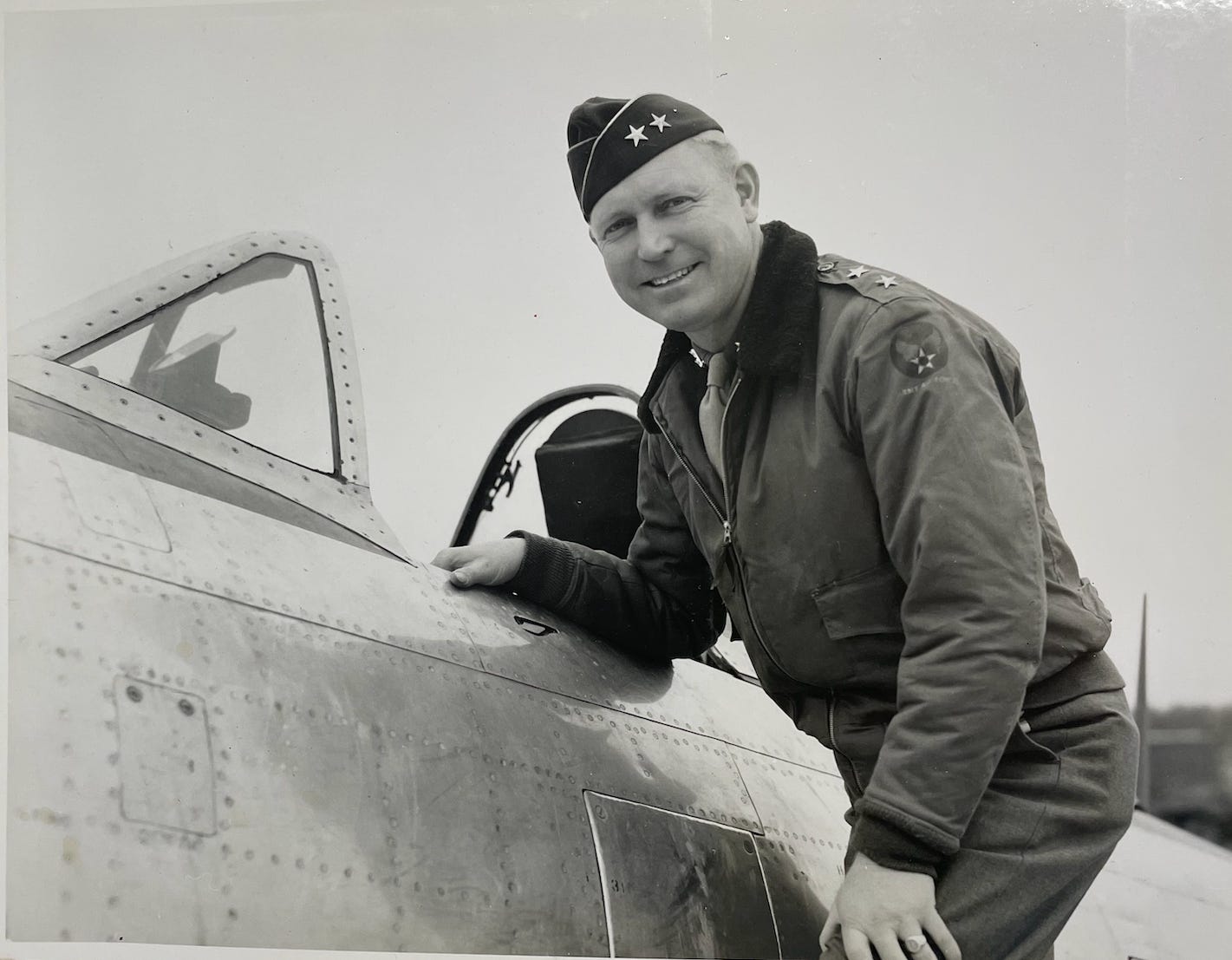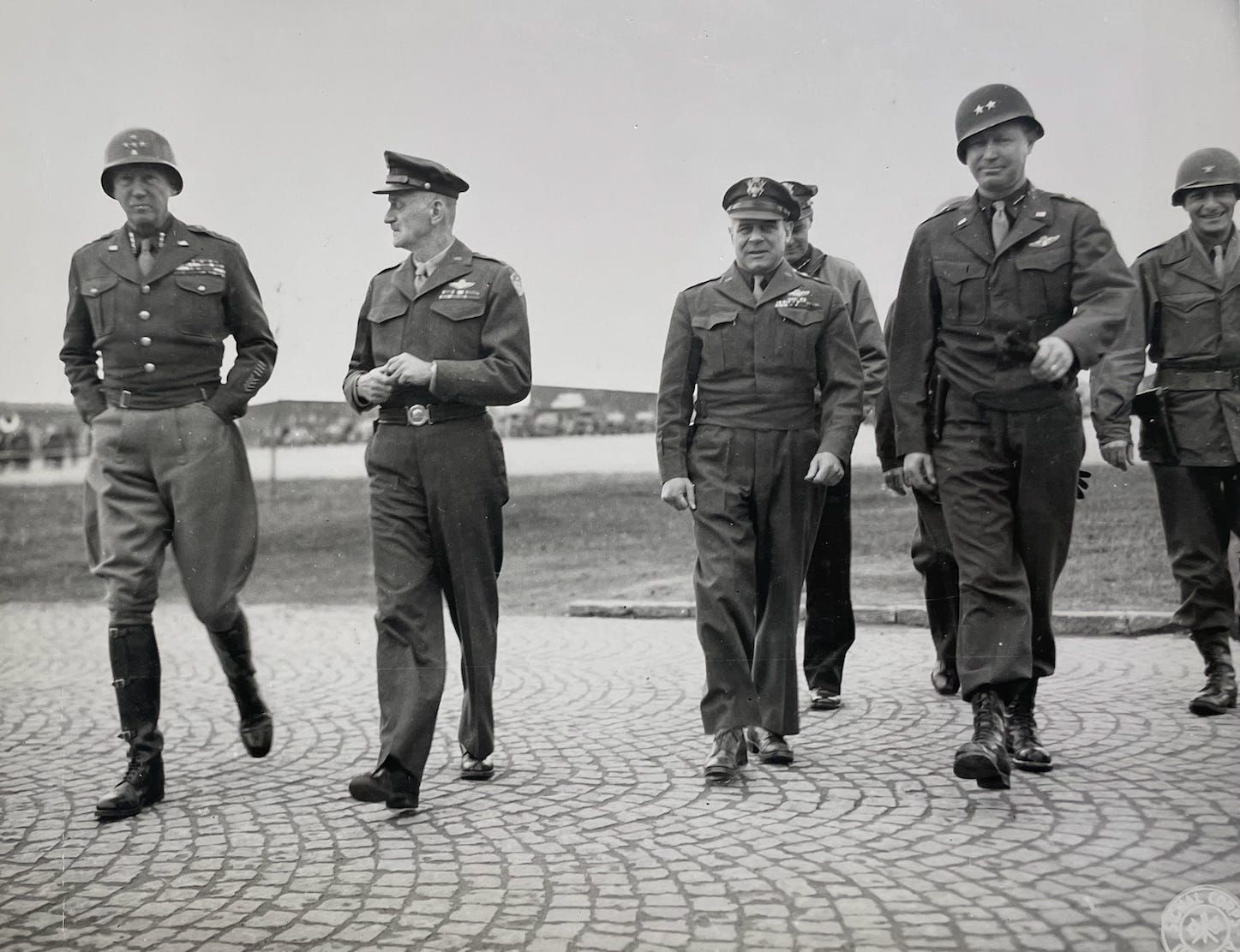Patton's Third Army and Weyland's XIX TAC Blitz Foundations
Author’s Note: Research on the Air Support Parties in Western Europe from August 1944 through May 1945 is still in progress. The primary source material on close air support during the time is sufficient to craft a narrative, but the sources on the ASPs, specifically, are hard to come by. Therefore, this article zooms out to Patton/Weyland’s air-ground partnership and the important impact of CAS on the ground war. It lays the foundation for the XIX TAC/Third Army relationship, while Part 2 provides more specific examples of excellent air-ground integration and close air support for Patton’s Third Army
Lieutenant General George Patton and his Tactical Air Command Counterpart, Brigadier General Otto P. Weyland
General George Patton is often referred to as the best American military mind of WWII and equally as often referred to as a great pursuer rather than a great fighter. This author believes that a great general should attack and destroy an enemy when they are weakest – in WWII, the Germans were weakest in retreat. Therefore, if Patton can be called a great pursuer rather than a fighter, it could (and maybe should) be perceived as a compliment. If a general can consistently force his enemy into retreat without a head-to-head fight, then he can more quickly end a war and end it with less bloodshed on both sides. An important question here should be, “How did Patton consistently force his enemy into retreat without committing to frontal assaults?” There is a strong argument that the answer is his strong relationship with XIX TAC commander Otto P. Weyland and his reliance on close air support as his primary tank killer.
It seemed unlikely that the two generals would get along well at first. Patton never got along well with Air Marshall Arthur “Mary” Conningham (the man from whom the US tactical air commanders modeled their own CAS systems), was overall unhappy with the performance of tactical air forces in North Africa, and was an outspoken advocate for the “air umbrella” concept. Although hot-headed and opinionated, Patton may have outgrown his distaste for close air support methods learned from his short stint in the Africa Campaign upon beginning his work with Weyland. Luckily for Third Army, Weyland was a perfect political fit to get Patton into his air-ground integration methodology. Weyland proved to be an excellent tactical air commander, but more importantly, his strong personality and willingness to confront his superiors were crucial for his relationship with Patton. The XIX TAC commander convinced Patton that he fully supported the ground campaign and was committed to providing close air support that matched Patton's need for Blitzkrieg-style maneuver tactics.[1] Weyland backed up his words and made XIX TAC the only one of the three TACs in the ETO to commit more sorties to close air support than any other mission (42% dedicated to CAS, 40% to interdiction).[2]
After a conference with Bradley on August 1st, Patton was tasked with pushing through the now-secured St. Lo, South to secure the Rennes and Fougeres region, turn West to capture the Brittany peninsula and ports, then to prepare to swing East and join the main push toward Paris.[3] For Weyland’s part, he had to rely completely on 9th Air Force’s inherent flexibility to support Patton’s operations. In early August, 9th Air Force did not assign Weyland a single fighter-bomber squadron, forcing him to borrow from Quesada’s IX TAC to support Patton’s VIII Corps offensive.[4] This may have been an advantage, since Quesada’s groups already had armored column cover experience under their belts.
Throughout most of August 1944, Weyland executed the CAS mission much like Quesada did during Cobra. He committed roughly a fighter group per armored division to perform column cover and to double as armed reconnaissance.[5] Weyland and Patton’s armored column cover tactics worked excellently in Brittany, where Patton requested that the armed reconnaissance and interdiction missions aim to keep the Germans in the battle space and not let them flee in order to regroup and re-engage. XIX TAC executed the mission, and Third Army ran into few issues capturing Brittany. Flexibility was another advantage of the armed recon mission; they could rapidly shift to close air support missions on the spot as long as a Rover/Air Support Party was supporting the unit in question. The constant presence of armed recon over the battle space negated the need for a responsive CAS request system in the early stages of Patton’s campaign. It allowed a five-to-ten-minute response time for close air support instead of an hour response within the established doctrinal framework.[6]
Patton and Weyland surpassed Quesada and Bradley’s effectiveness because the former leaned even harder into using close air support and ACC as an offensive weapon. As a display of Patton’s confidence in Weyland and XIX TAC’s ability to support his maneuvers, Patton did something that no other General in WWII would have done; during his mad dash across the Loire River in early August, Patton committed all his forces to a forward push and spared none to protect his flanks on the other side of the Loire. Instead, he left flank protection entirely up to the fighter bombers of XIX TAC. Weyland’s P-47s provided such thorough CAS for Third Army that one unit even specifically surrendered to XIX TAC, with the German commander insisting that he surrender to Weyland (without Patton) in person.[7] No other air commander in American military history has received such a surrender from an opposing ground force general.
Within the first week of Patton’s dominance of the Brittany and Breton peninsulas, XIX TAC underwent significant changes. Weyland was handed five fighter-bomber groups and was given the unprecedented authority to target whatever he deemed necessary without 9th Air Force oversight.[8] Additionally, the first wave of complaints from various corps commanders under Patton’s command came. Namely, they demanded a higher number of ASPs and ASPOs. Patton and Weyland mutually agreed that one ASP per division was too few. Part of the problem was that they needed more Rovers at lower echelons, and another problem was that the ASPOs were often fulfilling the Division staff G-3 (Air) role, thus detracting from their operational mission as ground controllers/Rovers with the front line tank columns.[9]
Otto Weyland photographed in his personal P-47 shortly after his promotion to Major General
To rectify the shortage, Weyland again borrowed from Quesada, who promptly supplied XIX TAC with ASPOs from IX TAC. In return, Weyland provided Quesada with additional CAS to Hodges First Army against a significant counterattack at Mortain. Once this problem was solved, yet another emerged that was again solved by quick-acting flexibility. This time, the complaints came from XIX TAC P-47 pilots who couldn’t make radio comms with the 4th Armored Division ASPO. The problem was diagnosed as a procedural issue. Pilots used the “C” net for all 9th Air Force air-to-ground comms, leading to theatre-wide net congestion once all three TACs were active in early August. A Lieutenant at XIX TAC recognized the problem and then created four radio nets, each with a different function based on task and location, for use across 9th Air Force.[10]
In all, the first five days of Patton’s campaign were executed in a highly efficient, and for Third Army and XIX TAC, nearly bloodless manner. Weyland planned well and utilized available assets wisely, always in accordance with Patton’s maneuvers. One example was his insistence on only P-47s for close air support and armed reconnaissance while using his light and medium bomber platforms for German Naval threats that threatened Patton’s flanks on either peninsula.[11] Weyland also proved wrong the FM 100-20 assumption that “close-in strikes” (FM 100-20’s chosen verbiage for close air support) were the most dangerous and most unprofitable.[12] The FM 100-20 writers were under the doctrinal assumption of air power superiority over ground armies. They saw close support as less profitable because targets were not as rich or impactful to the air war, or to the strategic effort. They failed to account for the mutual success that would be enjoyed through a harmonious air-ground relationship, as displayed by the XIX TAC/Third Army and IX TAC/First Army synergistic results.
In the first week of XIX TAC and Third Army operations, Weyland was able to nullify numerous growing pains in the Third Army/XIX TAC relationship, provide excellent support to Third Army, who secured their objectives unscathed, record an impressive number of air-to-ground kills, all with only three aircraft (all P-47’s) lost in combat.[13] Within six days, Third Army and XIX had secured the Brittany Peninsula and were ready to swing South to make up the Southern end of the envelopment of the Falaise Pocket.
Patton attends an XIX TAC pre-mission briefing. Weyland is in the front right, talking to Patton in the front center.
Much of Weyland’s success can be credited to mentorship from Conningham and his intensive study of the Quesada/Bradley relationship in the war's opening months, especially in the wake of Operation Cobra. His success can also be credited to Patton himself, who could have easily, given his track record, kept Weyland at arm's length. Instead, Patton showed faith in Weyland and leveraged all the tools at his disposal, with close air support in the form of ACC as arguably the most essential tool. It cannot be understated that Patton’s and Third Army’s early success was primarily due to the combined effects of air and ground forces. Patton and Weyland operated in a mutually enabling fashion, with such effective synchronicity that neither could be given more credit for swift victory in France in Third Army’s battlespace. Together, Patton and Weyland blew through the Germans using a much more effective version of their own Blitzkrieg. Not only did they essentially formulate the best blitz the world has ever seen, but they did it with a smaller force against a much more well-fortified and prepared force than the Germans had blitzed in 1939 and 1940.
Part 2 will include more specific examples and battles at the lower echelons within Third Army.
Patton meets with other top generals in 1945: Patton on the left, followed from left to right by Generals Carl “Tooey” Spaatz, James “Jimmy” Doolittle, Hoyt Vandenberg, Col. Paul Harkins, and Otto Weyland
[1] David Spires. “Patton and Weyland: A Model for Air-Ground Cooperation,” in, Airpower and Ground Armies: Essays on the Evolution of Anglo-American Air Doctrine 1940-1943. (Air University Press; Maxwell AFB, AL. 1998), 100-102.
[2] Report, Air Effects Committee, 12th Army Group, “Effect of Air Power on Military Operations, Western Europe.” Maxwell AFB; DAFHRA. July 15th, 1945.
[3] David N. Spires. Air Power for Patton’s Army: The XIX tactical air command in the Second World War, 139.
[4] Ibid., 140.
[5] Ibid., 148.
[6] Headquarters, Army Air Forces, Office of the Assistant Chief of Staff, Intelligence. Wings at War No. 5: Air Ground Teamwork on the Western Front. August 1944. (Call # K168.27-40 in the USAF Collection, DAFHRA, Maxwell AFB, AL), 6.
[7] Thomas Alexander Hughes. Overlord: General Pete Quesada and the Triumph of Tactical Air Power in World War II. (New York, NY: Free Press, 1995), 241.
[8] Ibid., 152.
[9] Ian Gooderson. Air Power at the Battlefront: Allied Close Air Support in Europe 1943-1945. (New York, NY: Frank Cass Publishers, 2005), 46.
[10] David N. Spires. Air Power for Patton’s Army: The XIX tactical air command in the Second World War, 156-157.
[11] Headquarters, Army Air Forces, Office of the Assistant Chief of Staff, Intelligence. Wings at War No. 5: Air Ground Teamwork on the Western Front. August 1944. (Call # K168.27-40 in the USAF Collection, DAFHRA, Maxwell AFB, AL), 14.
[12] Department of the Army. FM 100-20: Command and Employment of Air Power. 1943. 6-8.
[13] Army Air Forces Historical Office. Army Air Forces Historical Studies Number 36: Ninth Air Force April to November 1944. October 1945. Call # 101-36 in the USAF Collection, DAFHRA, Maxwell AFB, AL. 351.






